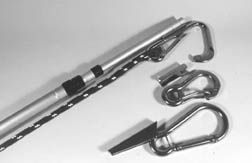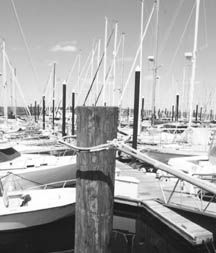Approaching your own mooring or dock always has a nice “home-again” quality. Lines are attached and often rigged to make it easy. It’s usually a piece of cake. When it’s blowing, you’re happy it’s something you’ve done often. Docking or picking up a mooring in a strange harbor is altogether different.

It’s made especially tremulous if the mooring has no convenient mooring lines ready to fish up with the boat pole but instead has just a ring in the top. The same goes if the dock is a marvel of clean design—no cleats, few pilings, perhaps only a tie rail, typically made of raised 2 x 4s along the edges of the dock.
On a boat with generous freeboard, grabbing the buoy or getting ashore with that first line or two can be the highlight of the day.
If it’s a mooring, a crew member first must capture the ring with the boat hook (no mean feat). Then there are three choices: (1) Have your pet gorilla lift the captured buoy up and thread a line through the ring; (2) have a crew member lay on his stomach and try to reach the ring, or (3) walk the buoy aft where the freeboard might make (2) easier. If wind or current makes boat control dicey or if you’ve overshot the buoy, the boat pole can become a cropper; once hooked, it’s surprisingly difficult to disengage.
If approaching a dock, a crew member carrying at least several lines must launch himself across whatever gap you’ve left, or—if you’ve made a truly dazzling approach—at least jump down onto the dock, whirl around and belay something to something.
With all these contretemps in mind, numerous inventors have worked hard on some devices to make this game less harrowing.
The collection mustered for this report includes some ingenious gadgets. Testing them made one feel like King Arthur, the bastard son of Uther Pendragon, skewering Sir Lancelot for toying with his wife, Lady Guinevere.
These devices fall into three general groups. All utilize a boat pole to: (1) place a snap hook on a buoy ring; (2) thread a line through the buoy ring, and (3) place a loop of line on a piling or cleat…or grab the edge of the dock.
Catching the Ring
There generally is, on the top of a mooring buoy, a substantial ring (usually 3″ in diameter), which is part of a long galvanized eye bolt that runs down through the buoy. The bottom end of the bolt has a swivel eye for attachment of the upper portion of the mooring chain.
Five of the devices in this report are hooks that, when rigged to a boat pole, make it relatively easy to place the hook, with its attached mooring line, on the ring. (Sailors call them snap hooks; Webster’s says only mountain climbers call them caribiners.)
In addition to the description offered here, an attempt will be made in the accompanying photos to show how each works.
Two of the hooks, made by Suncor and Wichard, are very similar. They fit in a U-shaped stainless steel stamping, which must be fastened to a boat pole with two screws or bolts. The bracket has notches to catch and hold open the hook’s torsioned gate. When the pole is withdrawn, the gate snaps closed. The Suncor comes in two sizes (4″/$21 and 5″/$24). The Wichard comes in three sizes (4″/$29, 5″/$49 and 7″/$57). Wichard also offers for $98 a fine pole that extends to 12′ and has the bracket already installed.
The Kong hook, a caribiner type with a spring-loaded gate, is different in that slots are crudely ground into both the hook and the gate to engage rails on the U-shaped bracket. As with the others, when the pole is withdrawn, the gate snaps closed. West Marine sells the Kong for $38.50.
Getting off the mooring with the Suncor, Wichard or Kong requires a bit more thought. The best solution is to replace the hook and line with a doubled line…working perhaps from a dinghy, when swimming or by bringing the buoy aft where less freeboard makes it easier to reach.
Still another device, new on the market, is the Larson Buoy Hook. It’s a bent hook made of 3/8″ stainless rod with a socket that fits loosely on the end of a boat pole. With the hook and mooring line held on the end of the pole by simple hand tension, it is meant to snag the buoy ring and permit disengagement of the pole, leaving the hook and line in place. The Buoy Hook sells for $45.

The fifth hook in the catch-the-ring category can be removed remotely, as well as attached, to the mooring buoy ring. It’s part of So-Lo Marine’s outstanding “hook system,” based on their Magic Stick. The caribiner-type hook has a welded-on triangular tab on the gate. On the pole is a spiral cage that twists onto the line and when forced toward the hook hits the tab and pushes the gate open so it can engage a buoy ring. The standard extending handle costs $39, the hook $31 and the spiral cage insert for the pole $55—total $125. There are other implements (brushes, mops, squeegees, fish spears, nets, gaffs, etc.) available for the basic Magic Stick pole.
Threading a Line
More intriguing, and in fact more useful in that they do two jobs in one, are three strange devices—one made by Stearns, which is known mostly for its watersport life jackets and vests; another developed in and imported from France, and the third, a Canadian product.
Both Stearns’ Happy Hooker™, RMC Marine’s Buoy-Clipper® and the Easymoor perform the seemingly impossible task of passing a line through the ring on the buoy and bringing the end back to the boat.
Stearns’ Happy Hooker™ does this with a yoke with a double-hinged structural arm (Stearns calls it a “link”) closing the open end of the “U”. The arms’ hinges are engineered to make one inoperative if the other is open. With a line rigged to one end of the arm, the Happy Hooker is shoved at a buoy ring, which opens one end of the link and then springs closed to activate the other hinge (with the mooring line), which is then carried back to the boat.
The Happy Hooker comes in two sizes. The small version ($28) made of acetal and glass-reinforced nylon with a jaw opening of 2″ can be mounted on a pole either in line or at 90°. A big rugged stainless model ($260), whose jaws will grab anything up to 4″ in diameter, is for a 1″ OD pole. Stearns said the U.S. Coast Guard is the major purchaser of the big expensive one.
RMC’s Buoy-Clipper is even stranger. It uses a bent stainless steel wire hinged arm to hold a line until it is, when thrust at the buoy ring, snapped across to a long V-groove. The end of the line, which pulls snug in the groove, comes free of the wire arm as the pole is withdrawn back to the boat.
Because the line can be inadvertently disengaged from the groove, the Buoy-Clipper takes a bit more care (and skill) than does the Happy Hooker. Because it includes a 6′ anodized aluminum pole that readily serves as a regular boat hook, the Buoy-Clipper carries a premium price ($94.50).
The Canadian-made Easymoor ($21.99 from West Marine) is the lightest, simplest and cheapest of all. Just three pieces of 30% glass-filled injection molded nylon, a small hinge pin and spring (both of 316 stainless), the Easymoor is another double-hinged device.
Because it is small, which accounts for its lightness, it uses a 1/8″ messenger line (to which the mooring line is tied with a sheet bend and a couple of half hitches) to engage the ring in the buoy. The hook’s jaw is too small to snag anything larger than 5/8″. It screws on the end of a standard 3/4″ Acme-thread pole.
Encircling a Piling
The final two devices are for those awkward occasions when the boat is in a slip or other situation where one just can’t quite reach the very piling that is needed for a good night’s sleep—especially if the overnight weather forecast guarantees some frontal action.

To preclude suffering the marina crowd wagering on how many throws it will take you to lasso the piling, consider Jatco Marine’s Dock Boy or another facet of the So-Lo Marine boat hook system mentioned above.
The Dock Boy is a docking fork with an ample 15″ jaw width. A mooring line is readied for placement on a piling by simply arranging the line on the fork and pressing it against sections of hook-and-loop tape, using two clips on the fork ends if necessary. The line must be fairly soft (or fuzzy) to engage the hook tape.
The Dock Boy, which attaches to a standard Acme pole, can place the line on the pole either as a simple bowline loop, a self-tightening loop based on an eye splice or with a line that doubles back to the boat. It can, of course, also be used to drop a loop on a cleat or bollard. BOAT/U.S. sells the Dock Boy for $33.50.
Finally, So-Lo Marine’s Magic Stick makes a second appearance in this report, this time as a “Piling Looper.” Inserted in the end of the pole, it has a “V” at the end and a short arm a foot down the pole to hold a line in a loose “U” shape.
With it rigged on a Magic Stick, one can drape a line on a piling or cleat in several different ways, including the doubled line that is so handy when casting off. It is a $20 accessory.
Bottom Line
For those who frequently cruise strange harbors and encounter a variety of mooring or docking situations, these devices can be useful, especially if the user becomes adept.
The Dock Boy docking fork is helpful when placing a line on a piling, but requires considerable stowage space aboard. So-Lo’s Piling Looper does the same job.
Of the held-open hooks on brackets, the Wichard is top quality, strong and easy to use. Suncor would be a nearly equal choice. These hooks make it easy to get secured to a buoy ring or anything small enough to accept the hook.
The So-Lo Magic Stick hook is slightly more difficult to use, because the pole and line must be held in tension together. However, because it can be removed almost as easily as it can be snapped to a buoy ring, it seems preferable. So-Lo’s line of all-stainless equipment, originally developed for fishermen, is made by a 103-year-old company whose main line of business is ladies’ garters and men’s suspenders. It looks like it would hold up very well.
Perhaps best of all in that they will place a doubled line on a buoy ring, Stearns’ Happy Hooker, the RMC Buoy-Clipper and the Easymoor are intriguing. Although very expensive, Sterns’ stainless steel model (mounted on a dedicated 1-1/8″ pole of your choosing) is Practical Sailor’s top choice. It even could snap a doubled line on a small tree in a stern-to-the-shore anchoring situation.
If the stainless Happy Hooker is too heavy (try it before you buy it), substitute the plastic Happy Hooker, which can be attached to any pole, or the lightweight Easymoor. The plastic Happy Hooker ($28) and the Easymoor ($21.99) are joint Best Buys.
Contacts- Buoy-Clipper, RMC Marine, 566 School St., Belmont, MA 02178-3630; 617/489-0399. Buoy Hook & Dock Hook, Larson, Inc., 2692 S. Camano Dr., Camano Island, WA 98292; 888/900-8801; www.dockinghook.com. Easymoor, Marine Innovations, 7058F Farrell Rd. SE, Calgary, Alberta, Canada T2H OT2; 403/253-4621; www.marineinnov.com. Happy Hooker, Stearns, Box 1498, St. Cloud, MN 56302; 800/697-5801, www.stearnsinc.com. Jatco Marine, 643 East Ave., Warwick, RI 02886; 800/982-9176. Kong Hook, West Marine, Box 50070, Watsonville, CA 95077-0070; 800/262-8464; www.westmarine.com. Magic Stick, So-Lo Marine, Box 5870., Bridgeport, CT 06610; 203/336-2700. Suncor Mooring Hook, Suncor, 7 Riverside, Pembroke, MA 02359; 800/394-2222, www.suncorstainless.com. Wichard Mooring Hook, Wichard, 47 High Point Ave., Portsmouth, RI 02871; 401/683-5055. www.wichard-usa.com.







































RFQ line reeving device